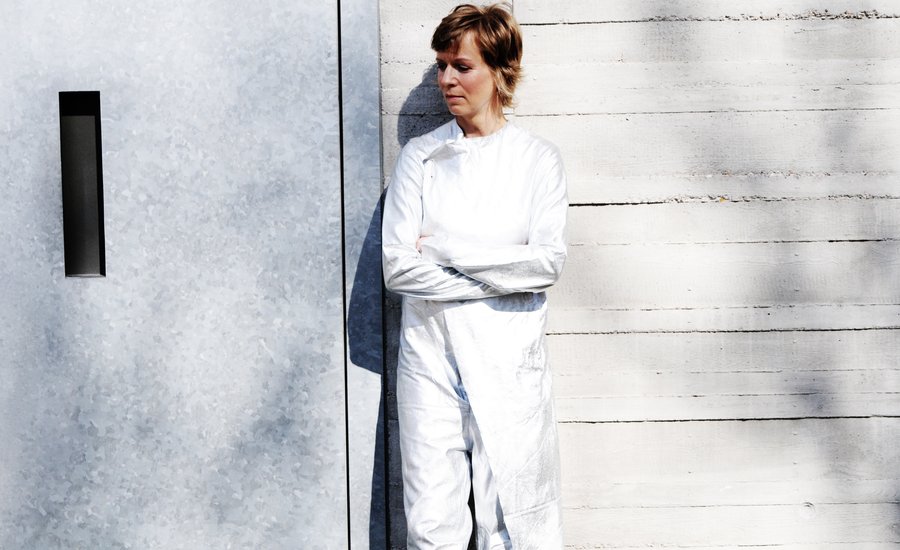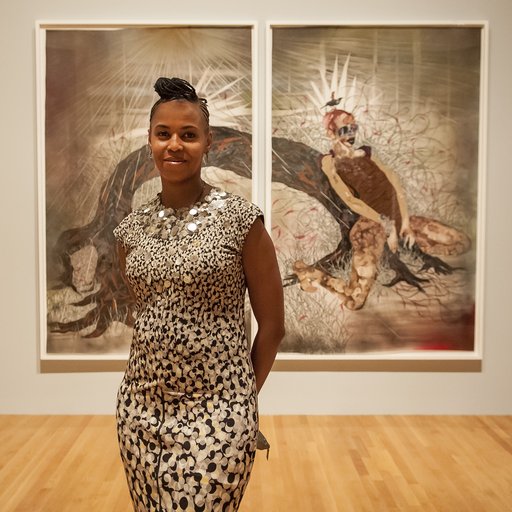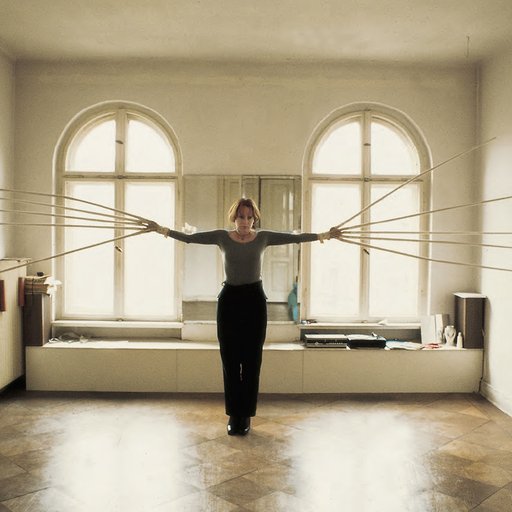In this excerpt from Phaidon’sAkademie X, the artist and Düsseldorf Art Academy professor Katharina Grosse recounts how she cultivated her singular approach to painting—the same one that’s found her composing her massive abstract pieces on abandoned houses, felled trees, and piles of rubble in solo shows everywhere from MASS MoCA to the Garage Museum of Contemporary Art in Moscow. As she has learned throughout her career, however, there’s much more to making art than having a good eye.
As a kid, when falling asleep or waking up, I always saw an imaginary paintbrush on the ceiling or the wall. It was busy erasing, or trying to erase, shadows and forms: cupboards, shelves, curtains. The brush’s movement would always be very orderly and follow the forms. Of course, this action was never successful, all stayed as it was—more or less static. Nevertheless, the rule was, until the wall was erased, I was not allowed to leave the bed. My imaginary paintbrush would keep me in bed until the wall had vanished. I was tied down by my own gaze. But this was the only form of painting I knew up until then and I didn’t think much about it. I was far more involved with, and enthusiastic about, classical music, football, tennis and mountain climbing—without being particularly gifted at any of them.
Later, I became hooked on painting out of the blue. My mother discovered a watercolor on my desk and suggested that I join an excursion for landscape painters. I spent the first day in a trench painting a willow tree for about eight hours. Actually, I couldn’t tell the tree from its surroundings, which made me understand a crucial thing about how I see the world: I do not see borders—not between foreground or background, nor between the visible and the invisible. I do not perceive the world through its recognizable forms, but through its possible appearances. I see the world as it is—as illusion.
When I was studying at the Düsseldorf Art Academy, I learned a lot about spiritual disciplines from different cultures and histories. I learned about them in relationship to the practices of my various teachers. I had the chance to meet and speak with Rainer Ruthenbeck, who referred to Transcendental Meditation, with Ulrike Rosenbach, who was an Osho student, and Gotthard Graubner, who was connected to Buddhist thinking. Working in the school’s studios I extended my commitment and visual intelligence. I got to know other artists’ strategies, to understand that it’s a game; to understand that if you do one thing it almost always excludes something else and that you have to make a choice.
During that period I also had enormous freedom to find out how doing and thinking are correlated. I realized that thinking is performative and therefore thoughts project space. I change the world by thinking about it in different ways and by giving space to these thoughts. Therefore I can actively create past, present, and future and let them happen at the same time. This simultaneity generates great freedom, energy and the conviction that nothing can go wrong. So I started to enjoy taking up the consequences of my actions within my practice and my everyday life.
I developed a strong sense of the directness of the way in which painting confronts me with the immediate consequences of my actions. I focused on how to fuse past, present, and future and as a painter to access that space without making the result homogeneous. And I had two important realizations: that it’s all about being unhindered by anticipated identities, and that painting is uninhibited thinking in public space. It could, for example, turn out to be inhibiting to read a recipe book like this one. If you assume that you’re supposed to be identical with the world, or even with yourself, you narrow things down unnecessarily. When you have a close look, you realize that neither the world nor yourself ever look the same. All is ever-changing and therefore all is possible at any time.
Even though it doesn’t always seem that way, and this potential isn’t always visible, it’s mandatory to found your thinking on this assumption so that you don’t undermine your possibilities. I work in an open field that spreads rhizomatically. That means that as the author of the painting, I am just a link among other links; I have the same status as the paints, the architecture, the time, the viewer, etc. I do not believe in causality, nor in before and after, but in simultaneity and equality. I do not paint a representation or a vision; perhaps I paint blindly rather than seeingly. I cannot do it any other way because my paintings are sometimes so big that I cannot survey them while I work. The visual identification of what we’ve always understood is strange to me.
I traveled to Europe’s most amazing museums to see all the paintings I could in the flesh, over and over again. Fresco painting got my attention, and its relationship to the building, which made me realize that a painting could appear everywhere: on my shoulder, on my knee, up in a corner of a room, in a cave or in the volume of the space. Painting is the most highly developed user surface we have.
To expand on that thought, anything can be inspiring—from Edvard Munch leaving his paintings in the snow, which may lead you to treat your work in an unexpected way, to van Eyck’s Madonna in a Church, or even the Dallas Cowboys Football stadium’s gigantic screen, which may help you to understand the difference between scale and size.
I’ve held a very independent position in my thinking and working. I was gently, but not overtly, encouraged by my professors. After leaving art school I shared studios with small groups of artists but have never been part of a close community of artists.
It’s important for young artists to be clear about what they want. When thinking about what galleries they want to work with they need to consider whether they want financial success, comfort, and support, or eventual fame. I look for dealers who challenge me. I had my first gallery representation when I was thirty-five. I never worked for another artist as an assistant, but this is a great way to learn about the business side of running a studio and introduces you to the day-to-day demands of producing and exhibiting work. I learned about running a studio just by doing it. Making the decision to archive all my work meant that I had to run things professionally: employ photographers, office assistants, and set up an office. I’ve learned the business side of things, step-by-step, reading books and sharing experiences with friends. These days I employ professionals and experts in managing the studio side of things.
When I look back through my work since being a student, it’s easy to articulate the steps taken. It’s much more difficult to talk about what I’m currently doing or involved with. Working is a totally engrossing process that goes far beyond language or the immediately explicable.
Assigned Reading, Viewing, and Listening
Reading
Catton, Eleanor. The Luminaries. London: Granta, 2013.
In this novel, all is interconnected. The story is told through the lenses of past and future at the same time.
Kristóf, Ágota. Le Grand Cahier. Paris: Seuil, 1986. Translated by Alain Sheridan as The Notebook. New York: Grove/Atlantic, 1997.
Dry, sharp, compressed: a novel without an escape door.
Müller, Herta. Atemschaukel. Munich: Carl Hanser Verlag, 2009. Translated by Philip Boem as The Hunger Angel. New York: Metropolitan Books, 2012.
Müller creates images so vivid that they hurt. Here, a poem of razor-shape language is turned into a novel.
Wallace, David Foster. Infinite Jest. New York: Little, Brown and Company, 1996.
Ever-changing spatiality and points of view. You become a pulse, on and off. Vertigo.
Yogananda, Paramanhansa. God Talks with Arjuna: The Bhagavad Gita. Los Angeles: Self-Realization Fellowship, 1995.
Why are we on this planet? What is the internal world and what is the external world? Pandava prince Arjuna asks the Hindu god Krishna all the questions he longs to know.
Viewing
Stevenson, John and Mark Osborne, dirs. Kung Fu Panda. Paramount Pictures, 2008. Film.
Beautifully rendered, humorous wisdom.
Listening
Wagner, Richard. Der Ring des Nibelungen (The Ring of the Nibelung). 1848–74. First performed Bayreuth, Germany, 1876. Operas.
Everything sounds, the eye, the tongue, the bird, the water, the wind. Your body vibrates.
READ MORE FROM AKADEMIE X ON ARTSPACE:
6 Art-World Lessons From the Unorthodox Classroom of Akademie X
Chris Kraus on the Ambiguous Virtues of Art School
Words to Live By: Marina Abramović's Mystical Maxims for Artists
Venice Biennale Representative Joan Jonas's Workout Regimen for Artists
The Four-Hour Art Week? Read Carol Bove's Self-Help Guide for Artists
Sanford Biggers’s Tough-Love Guide to Surviving the Art World
Go On a New York City Scavenger Hunt With Artist Mark Dion
Ólafur Elíasson’s 9 Foolproof Tips for Urban Inspiration
Painter Carrie Moyer on Her Polyamorous Relationship With Art
“They Eat Because You Grow the Food”: Wangechi Mutu’s Words of Wisdom for Struggling Artists
























